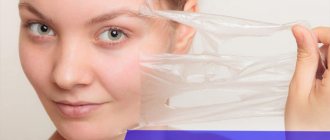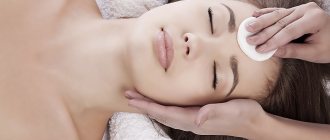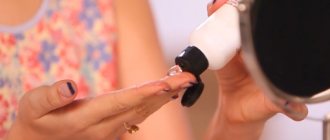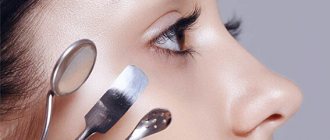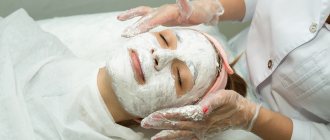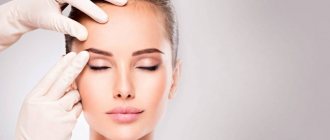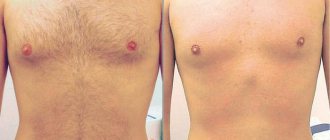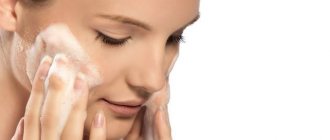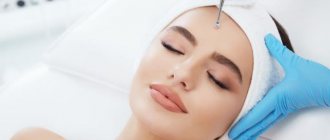Description of cosmetic procedures
Peeling or facial cleansing, which is best for you depends on your goals and the final result.
Facial cleansing is a hygienic procedure for cleaning the skin from acne, sebaceous plugs, blackheads, closed comedones, milia, post-acne, and stagnant spots.
Facial cleansing is a hygienic procedure for cleaning the skin from acne, sebaceous plugs, blackheads, closed comedones, milia, post-acne, and stagnant spots.
As a result of such cleansing, the skin begins to breathe and intensively renew itself. More suitable for problem skin. The main advantage of cleansing is the complete removal of problematic skin from inflammatory elements, stagnant spots, comedones, etc.
Peeling is a procedure for deep cleansing of the skin (epidermis) using acids of various origins and concentrations that dissolve the top layer of dead cells, sebum.
Peeling is a procedure for deep cleansing the skin (epidermis) using acids of various origins and concentrations.
After removing the top layer, the skin begins to intensively recover, regeneration improves, the barrier capabilities of the skin increase, the production of collagen, elastin, hyaluronic acid is restored, and metabolic processes in the cells of the epidermis are normalized.
https://youtu.be/https://www.youtube.com/watch?v=p4PM_I5Es_A
What is carbon facial peeling?
Carbon peeling is very often called " carbon peeling ". Because the main component of the procedure is a special nanogel, which contains carbon dioxide (or otherwise “carbon”).
This peeling takes place in two stages. First comes the chemical, “carbon” effect. It will smooth it out like an activated carbon mask on your face. By the way, thanks to this part, the carbon peeling procedure is sometimes called “ carbon facial cleansing .”
At the second stage, it is time for the laser. They warm up the inner layers of the epidermis. Because of this, the impact becomes deeper. The laser exfoliates dead cells and stimulates collagen production. In this way, a multi-effect can be achieved: the skin is thoroughly cleansed, smoothed and rejuvenated.
»»» Best recipes : Homemade face masks for acne and blackheads.
Comparative characteristics of procedures
We will conduct a detailed comparative analysis of peeling and facial cleansing to understand what is best for your skin.
We will conduct a detailed comparative analysis of peeling and facial cleansing to understand what is best for your skin.
Indications for the procedure
You are recommended for a cleansing procedure if your face has:
- acne;
- black dots;
- comedones;
- milia (millet);
- post-acne;
- stagnant spots;
- sebaceous plugs;
- increased skin oiliness.
Treatments for skin problems are indicated for you.
Peeling is recommended by cosmetologists for:
- increased fat content;
- age spots;
- wrinkles;
- dull complexion;
- loss of elasticity;
- other age-related skin changes.
What skin type is it suitable for?
Facial cleansing is recommended for those with oily, problem skin, as well as teenagers.
However, owners of normal and especially combination skin also sometimes require mechanical relief from the above problems.
Facial cleansing is recommended for those with oily, problem skin, as well as teenagers.
Facial cleansing is acceptable for use in adolescence , when most schoolchildren develop skin problems associated with hormonal changes in the body.
Peeling is applicable to all skin types. Fading, aging skin especially needs it. You can begin peeling procedures as early as 25 years of age.
You may find this article useful on the topic: Henna for eyebrows: how to choose high-quality henna
Which cleansing is better?
The question of what is better for the face - peeling or professional cleansing - sounds a little incorrect, since both of these manipulations are indicated for different problems.
Indications for peeling:
- The first age-related changes in the skin.
- Dull color.
- Decreased elasticity.
- Uneven, rough surface.
- Enlarged pores.
- Acne marks, pimples, small scars and scars.
- Pigmentation (seasonal or age-related).
Indications for professional cleaning:
- Copious secretion of the sebaceous glands.
- Enlarged pores.
- Presence of blackheads.
- Acne, blackheads and pimples in large quantities.
- Atonic (flabby) skin.
After an individual examination, the cosmetologist, taking into account the characteristics of the client’s skin, will select a cleansing procedure that will give a noticeable result.
It's never too late! How to get youth and beauty using the best methods of cleansing and renewing your skin? Choose:
- Carbon peeling.
- Gas-liquid.
- Azelaic.
- Ferulic.
- Enzymatic.
Types of cleaning and peeling
Types of facial readings differ in the type of effect on the skin.
Types of facial readings differ in the type of effect on the skin.
Manual (manual, mechanical) cleaning
A cosmetologist manually removes unwanted elements from the facial skin.
When the influence of only the fingers is not enough, it is possible to use special cosmetic instruments:
- Spoon Uno. Allows you to quickly and effectively remove comedones and pimples from the skin. The procedure is quite traumatic and can be painful.
- Brushes (brushing). Special brushes are used that do not penetrate deep into the skin, but “sweep” sebum out of the pores and get rid of plugs.
- Vidal's needle. It has a very thin and sharp tip; it is used to puncture closed comedones and pimples before further removal.
- A loop. A metal loop allows you to remove sebaceous plugs, blackheads, and the contents of hair follicles from the pores.
A cosmetologist manually removes unwanted elements from the facial skin. When the influence of only the fingers is not enough, it is possible to use special cosmetic instruments.
Vacuum cleaning
A less traumatic procedure for cleansing pores. It is carried out using a special device with a tube nozzle , at the end of which an area of negative pressure is created.
This tube, like a small vacuum cleaner, literally pulls out sebaceous plugs, comedones, cosmetic residues from steamed pores, and removes dead cells.
If there are inflamed elements on the skin of the face, the cosmetologist will first remove them mechanically, observing all sanitary measures. Depending on the strength of the impact, the procedure may be painful.
A less traumatic procedure for cleansing pores. It is carried out using a special device with a tube attachment, at the end of which an area of negative pressure is created.
Ultrasonic cleaning
Using a special device (ultrasonic scrubber), under the influence of ultrasonic vibrations, the pores are opened, their contents are destroyed, and the top layer of skin is removed.
As a result:
- skin elasticity increases;
- the production of collagen and elastin increases;
- wrinkles are smoothed out;
- the relief of the skin is evened out.
The procedure is absolutely painless and does not last long. It is very gentle on the skin.
Using a special device (ultrasonic scrubber), under the influence of ultrasonic vibrations, the pores are opened, their contents are destroyed, and the top layer of skin is removed.
Simultaneously with the destruction of the contents of the pores during ultrasonic cleaning, micromassage of the skin occurs, which promotes regeneration, and lymphatic drainage, which eliminates swelling. Another advantage of ultrasound is that exposed young skin cells are better able to accept care products.
Galvanic cleaning (disincrustation)
It is produced using a device that emits microcurrents , which imperceptibly and quickly break down the contents of enlarged pores. Before the procedure, a special gel is applied to the surface of the skin (excluding the areas of the lips and eyes), which plays the role of a current conductor and ensures better glide of the device.
Under the influence of microcurrents, the contents of the pores are destroyed and removed outside, where, interacting with the gel, they are converted into a soap solution.
Under the influence of microcurrents, the contents of the pores are destroyed and removed outside, where, interacting with the gel, they are converted into a soap solution.
In terms of effectiveness, galvanic cleaning is comparable to manual cleaning, however, there is no damage to the skin and no pain.
Facial peeling is divided according to the degree of deep impact on the skin.
It is produced using a device that emits microcurrents, which imperceptibly and quickly break down the contents of enlarged pores.
Superficial peeling
It is carried out using fruit acids (AHA acids): malic, lactic, almond, glycolic, tartaric in low concentrations. This type of peeling affects only the surface layer of the epidermis, which does not have living cells.
Effective removal of dead cells occurs, sebum dissolves, and the thickness of the surface layer of the skin decreases. Thanks to this, skin regeneration improves, fine wrinkles are smoothed out, the relief is evened out, unhealthy complexion goes away, pigment spots are reduced, and skin oiliness is reduced.
This peeling is suitable for young skin (from 25 years old) and helps to preserve youth for a long time.
This peeling is suitable for young skin (from 25 years old) and helps to preserve youth for a long time. Superficial peeling can be carried out in a course of 7-10 procedures with a break of 10 days.
Medium peeling
Able to penetrate living cells and promote their exfoliation.
Medium peeling gives a powerful message for skin regeneration. New cells are formed, new capillaries appear, and the production of collagen and elastin is activated.
The course of medium peeling consists of 1-3 procedures with a break of 1 month.
Medium peeling gives a powerful message for skin regeneration. New cells are formed, new capillaries appear, and the production of collagen and elastin is activated.
Deep peeling
Deep peeling (phenolic) is designed to completely remove old skin. The skin literally dissolves to its maximum depth. Only the thinnest layer of cells remains unaffected, the so-called growth zone, from which further restoration of epidermal tissue occurs.
Recommended phenol peeling for skin:
- with pronounced age-related changes;
- with deep wrinkles;
- with sagging areas;
- with senile pigmentation;
- in the presence of areas of scar tissue.
Deep peeling (phenolic) is designed to completely remove old skin. The skin literally dissolves to its maximum depth.
The procedure is painful and requires the use of painkillers both during and for 2-4 days after.
It is important to know! All deep peeling compositions are based on phenol in a fairly high concentration. This substance is toxic; if it gets into the blood, it can cause arrhythmia, so it should not be used by people with heart, kidney, or liver diseases, or if they have a pacemaker.
Therefore, this procedure can only be carried out by a highly qualified cosmetologist and only in a cosmetology clinic!
This procedure can only be carried out by a highly qualified cosmetologist and only in a cosmetology clinic!
Read an interesting article about: Biotattooing of eyebrows with henna: reviews and results
Types of professional cleaning
Facial cleansing can be done both at home and in beauty salons. The latter provide significant bonuses: absolute safety, individual approach and the ability to use innovative technologies. Depending on your skin type and its problems, a specialist may recommend different types of cleansing.
Manual
This procedure is the simplest. Its essence is to squeeze out pimples from pre-steamed skin with the fingers of a cosmetologist or a special Uno instrument, which has a spoon with holes on one end and a metal loop on the other. The attachments on it, however, can change. With this method, the contents of the pores easily slip out and settle on the surface of the device. The mechanical cleansing method is suitable for those who have oily or combination skin types, clogged pores, acne and visible inflammation. Experienced cosmetologists delicately, scrupulously, in compliance with all aseptic standards, treat every defect detected with a magnifying glass. As a result, the face becomes cleaner and smoother.
Hardware
Hardware cosmetology is becoming increasingly popular due to its non-traumatic and painless nature. These advantages are ensured by the fact that almost any device affects only the upper layers of the epidermis. There are several types of hardware cleaning.
Ultrasonic
This procedure is performed with a scrubber, a device that gently removes dead skin cells from patients. The device has two activity modes: pulsed and continuous. Its active part resembles a spatula with pointed corners and a concave middle. It is connected to an electronic unit, from which ultrasound emanates, massaging the skin. The use of a special gel helps these waves penetrate even deeper into the dermis. This micromassage enhances lymphatic drainage and blood circulation. As a result, tissue swelling decreases, and the skin becomes velvety, well-hydrated and elastic.
Due to the portability of the scrubber, this type of cleaning can be done both in the salon and at home.
Galvanic
The tool needed here is a galvanic device that produces direct electric current. Its main element is a nozzle with negatively charged electrodes. It can be a roller with a porous surface wetted with an electrolyte solution. The weak tension it creates drowns sebum, and the acids secreted by the sebaceous glands react with the alkaline agent previously applied to the face. After 12 minutes, soap foam forms on the surface, which can be easily removed.
The procedure begins with an impact on the chin, and then moves along the massage lines. The current intensity is first gradually increased, then slowly decreased. During the process, the patient feels warmth and tingling. At the end of galvanotherapy, the polarity of the electrode is changed and moved over the face to restore the ph balance of the epidermis.
Disincrustation can also be done at home.
Vacuum
For this cleaning, a vacuum apparatus is used, which operates on the principle of a vacuum cleaner. Here you need to adhere to consistency. First, make-up is removed, then the face is steamed, thereby opening the pores, and a drainage tube is applied to the skin. After this, a pigment-constricting mask is required.
The vacuum device acts more gently and pleasantly than the hands of a specialist. People compare this method to a relaxing micro-massage. Ideal cleansing will not be achieved, but the skin will gain tone, radiance and a healthy color.
Features of the procedures
Each type of procedure (peeling or facial cleansing) has its own characteristics. Let us consider in detail: what needs to be done for the best effect, what to pay special attention to, what is the algorithm of actions for each procedure.
Important to remember! When carrying out any type of peeling or facial cleansing, the fundamental principle is sterility.
Any facial cleansing begins with cleansing the face of decorative cosmetics.
Any facial cleansing begins with cleansing the face of decorative cosmetics. Next, you need to remove the upper keratinized layer of cells (scrubbing, brushing, gommage) and soften (steam) the skin. Next, the skin is treated with a special disinfectant lotion containing isopropyl alcohol.
Actually, after preparation, the cleaning procedure itself begins. What type of cleaning (manual, machine or combined) is necessary will be decided by a cosmetologist, based on the characteristics of your skin.
When carrying out any type of peeling or facial cleansing, the fundamental principle is sterility.
To complete the procedure and to consolidate the achieved results, the cosmetologist can use:
- Bioptron. The device affects the skin with biocurrents, which promotes the resorption of comedones, reduces inflammation, and improves skin regeneration.
- Darsonval. Low-intensity currents have a tonic, disinfecting effect on the skin and improve blood circulation.
- A liquid nitrogen. Effective in combating acne, eliminates inflammation, and promotes wound healing.
At the last stage of cleansing, a special mask is applied , which soothes the skin, tightens pores, and promotes healing of damage. Afterwards, the mask is washed off and a protective agent is applied.
Bioptron. The device affects the skin with biocurrents, which promotes the resorption of comedones, reduces inflammation, and improves skin regeneration.
Stages of facial peeling:
- cleansing of makeup and other cosmetics;
- complete degreasing of the skin surface (except for the mid-peeling procedure, which uses trichloroacetic acid);
- applying the acid solution directly to the skin;
- applying an alkaline solution that neutralizes the acid;
- Thorough washing with running water;
- treatment with a disinfectant composition;
- applying a protective agent.
Techniques for applying chemical peels may vary depending on the composition and manufacturer.
Any type of chemical peel makes the skin thin and sensitive to ultraviolet rays. It is necessary to use protective products with UVA and UVB filters.
Note! Any type of chemical peel makes the skin thin and sensitive to ultraviolet rays. Therefore, it is preferable to carry out the peeling procedure from November to March, when solar activity is minimal.
also necessary to use protective products with UVA and UVB filters.
Effect
Of course, every girl has her own expectations of this or that procedure, the desire to see her skin perfect. In most cases, the effect is justified.
Of course, every girl has her own expectations of this or that procedure, the desire to see her skin perfect. In most cases, the effect is justified.
As a result of facial cleansing, the patient receives:
- relief leveling;
- getting rid of blackheads and comedones;
- acne treatment;
- reduction of skin oiliness;
- fresh complexion;
- lightening of stagnant spots.
Visible effects of facial peeling:
- lightening pigment spots;
- smoothing wrinkles;
- relief leveling;
- even out complexion;
- restoration of elasticity;
- prolongation of skin youth.
After the treatments, you will notice how much better your skin has become.
How is carbon facial peeling done?
The duration of the carbon facial peeling procedure is short - about half an hour.
First, the skin is cleaned of impurities, treated with an antiseptic, and nanogel is applied.
When the gel dries, the cosmetologist treats problem areas with a laser. Never touch the areas around the eyes and lips. The main focus of the procedure is on the T-zone and cheeks.
During the procedure, pain may occur, especially in the nose area, as if being pierced with long sharp needles. Very often this is due to a violation of the skin - cracks or inflammation in the skin. Among other unusual sensations, the face noticeably warms up. In addition, you can hear a noticeable clicking sound from the device throughout the procedure.
After the procedure, the cosmetologist applies a soothing cream to the skin.
»»» Ingredients of cosmetics: How to choose facial products?
How long does it take for skin to recover after treatments?
The recovery period after peeling or facial cleansing procedures varies and depends on the depth of the effect on the skin.
After the procedure of mechanical facial cleansing, the skin is restored within 3-7 days, depending on the complexity of each specific case.
Hardware types of cleaning do not entail long-term recovery. Immediately after the procedure, you should not apply decorative cosmetics, but the very next day you can continue to lead a normal lifestyle.
After superficial peeling, recovery usually lasts 1-2 days and sometimes does not even have consequences in the form of peeling of the skin.
After superficial peeling, recovery usually lasts 1-2 days and sometimes does not even have consequences in the form of peeling of the skin.
Medium peeling affects the deeper layers of the skin and full recovery occurs within 7-10 days.
Deep peeling is the most aggressive and requires hospital conditions for the procedure and the first 4-7 days after it. The skin is completely restored after 2-10 weeks.
What peelings are suitable for acne?
The purpose of peeling is to destroy the top layer of skin and ensure the removal of inflammatory products. With the help of special substances, the dermis is subjected to a chemical burn. Once dead cells are removed, the recovery process is accelerated. The procedure increases blood circulation, the cells receive more oxygen. The advantage of this method of treatment is the absence of negative consequences in the form of post-acne.
- Superficial peeling is most often used against acne. With its help, the skin and pores are cleansed, cell respiration processes are restored, and secretion production is reduced. In this case, trauma to the epidermis is minimal.
- The middle type is used to remove scars, scars, and acne spots.
- Acid exfoliation, according to reviews from cosmetologists and clients, is a good peeling for acne, as it gently solves skin problems.
We suggest watching a video about which peelings are best for getting rid of acne:
Glycolic
Glycolic acid is gentle on the dermis, easily tolerated and highly effective in treating acne. The main action is aimed at clearing clogged sebaceous ducts. After removing dead particles, skin permeability improves, which leads to increased effectiveness of whitening products. Peeling with glycolic acid is not recommended when acne has a papulopustular form, as it causes an exacerbation of the disease.
Benefits of exfoliation with glycolic acid.
- Short recovery period.
- Low likelihood of complications.
- No discomfort during the session.
Sometimes an addictive effect is observed if you use products with glycolic acid for two months.
After exfoliation, sensitivity to ultraviolet radiation greatly increases, so it is necessary to use sunscreen compounds.
The rash sometimes gets worse after peeling. This is due to the acceleration of metabolic processes. Antibacterial care products will help reduce the risk.
Salicylic
Salicylic peeling is indicated for teenage acne. It is also prescribed to lighten pigmentation, seborrheic dermatitis, and superficial wrinkles. It is suitable for any photo type.
The molecules of the active substance penetrate the follicles, dissolve blackheads, and help remove excess sebum.
Depending on the concentration, the procedure affects the upper (15-20%) or middle (20-30%) layers of the epidermis. Salicylic exfoliation cannot remove the pronounced effects of acne in the form of scars and scars; stronger substances will be required.
Often, to soften the harsh effects of salicylic peeling, fruit acids are included in the composition.
Yellow
The drug contains several components: retinoic, phytic, kojic and azelaic acid. This complex of substances acts in many ways. But its main purpose is to combat age-related changes. In the case of acne, the condition may worsen. However, exfoliation normalizes sebum production, cleanses pores, which serves to prevent the formation of purulent rashes.
Yellow peeling exfoliates dead skin cells well, starts the regeneration process, lightens dark spots, and evens out the appearance. The procedure can be easily tolerated even by people with sensitive skin.
Ferulic
This type of peeling is considered superficial. It works very gently. In most cases, after exfoliation there are no unpleasant symptoms: severe peeling, swelling, itching.
The composition, in addition to ferulic acid, includes salicylic, malic, lactic, ascorbic and glycolic acid. The action of exfoliants is primarily aimed at combating aging. But it also regulates the production of skin secretions, cleanses pores, treats acne, and eliminates its consequences.
Acne peels based on ferulic acid require pre-treatment of the skin for 7-10 days with products containing fruit acids.
Almond
This type of exfoliation is considered the most gentle. Due to its large size, mandelic acid molecules act slowly and affect only the surface layer of the skin. Exfoliating almond peeling effectively removes dead cells, fights the manifestations and consequences of mild to moderate acne.
The almond exfoliation procedure can be performed at any time of the year. It is suitable for all skin types and different age groups.
Trauma to the dermis is minimized. In the first days, the client may experience dryness and tightness, but the problem is easily eliminated by applying a moisturizer.
Contraindications for carrying out
Contraindications for facial cleansing are:
- hypertonic disease;
- psoriasis and eczema;
- epilepsy;
- herpes;
- dry, sensitive skin;
- menstruation period;
- mental illnesses;
- individual intolerance.
Facial cleansing should not be done during menstruation.
Peeling cannot be performed under the following conditions:
- pregnancy and lactation;
- hypertension;
- heart and kidney diseases;
- infectious diseases;
- increased skin sensitivity;
- psoriasis and eczema;
- herpes;
- increased body temperature;
- mental illnesses;
- epilepsy;
- individual intolerance.
Whatever procedure you choose (peeling or facial cleansing), it’s up to you to decide what’s best for your skin. However, the cosmetologist is obliged to warn you about the possible consequences.
The cosmetologist is obliged to warn you about the possible consequences.
Possible consequences are as follows:
- peeling of the skin;
- redness;
- dehydration of the epidermis;
- scar formation;
- swelling;
- increased skin sensitivity.
Find out about: Eyebrow microblading: before and after photos
When is the best time to do carbon peeling?
In principle, carbon facial peeling can be done at any time of the year, even in summer, but with minor reservations.
If you still decide to have the procedure during a hot period, then be prepared to sit at home for about a week. Plus, use extra sun protection afterwards.
Carbon peeling is perfect for spring. As a rule, this is the time when we suffer the most from lack of vitamins, so a dull complexion is not uncommon. And peeling solves this problem very effectively. For the same reason, it is also suitable for the autumn period.
In winter, you should pay attention to the condition of your skin. If there are cracks, peeling, or the skin has become excessively dry, it is better to wait with the procedures until better times. In any case, after carbon peeling in the cold, you will have to sit at home until the skin recovers, and then regularly use a good protective cream against frost and sunscreen cosmetics.
»»» Beauty vitamins. Find out 10 interesting facts...
Price
Prices for peeling or facial cleansing procedures vary and depend on the level of professionalism of the cosmetologist, the components, preparations, and equipment used, which best reflects the price-quality ratio.
Prices for peeling or facial cleansing procedures vary and depend on the level of professionalism of the cosmetologist, the components, preparations, and equipment used.
The cleaning procedure costs in the range of 350-7500 rubles.
The price of facial peeling can be 650-15,000 rubles.
When choosing a place for the procedure, rely on your financial capabilities and customer reviews.
Recommendations from cosmetologists
Experts advise taking a responsible approach to choosing a cleansing procedure. This should be done taking into account the condition and type of skin:
- Normal epidermis without visible defects - ultrasonic cleaning with a device with a special “spatula” attachment.
- Oily type with rashes and blackheads - manual therapy with an Una spoon and a certain type of gel. Scrub and cleanse with fruit acids (malic, mandelic).
- Dry skin - rolling, light cream peeling, laser cleaning at the same time.
- The problematic type is retinoic or salt acid peeling.
If you are going to carry out the procedure at home, carefully consider the choice of drugs. Today, the market offers ready-made solutions for deep cleansing and rejuvenation of the skin at a relatively affordable price, which you can use yourself after reading reviews.
For a visual effect, we recommend taking a “before” photo to evaluate the result after the procedure.
Skin care for quick recovery
The recovery period after peeling or facial cleansing procedures varies; what is best to use for speedy skin healing and maintaining the achieved result, your cosmetologist will tell you in detail.
It is recommended to use mild cleansers and moisturizers, soothing lotions, and, if necessary, healing ointments.
General rules of care after cleaning:
- After cleansing your face, you should not wash your face for at least 12-16 hours.
- When peeling, do not tear off the crusts by force.
- Avoid contact with sunlight for 2 days.
- Do not use alcohol lotions for at least 7-10 days.
- It is recommended to use mild cleansers and moisturizers, soothing lotions, and, if necessary, healing ointments.
General rules for post-peeling care:
- After chemical peeling, you should not wet your face for 24 hours (after deep peeling, this period reaches 3-4 days).
- Do not remove any crusts that form.
- You cannot sunbathe or visit the solarium.
- Do not use lotions containing alcohol.
- It is worth using products with a high level of protection against UV rays, cleaning as gently as possible.
- The use of moisturizing creams with antioxidants is recommended.
After chemical peeling, you should not wet your face for 24 hours (after deep peeling, this period reaches 3-4 days).
Before deciding whether to choose a specific procedure: peeling or facial cleansing, determine what best solves your skin problems.
Be sure to visit a cosmetologist's office for a consultation . After the examination, the doctor will recommend you a more suitable peeling or facial cleansing procedure (possibly a combination of both) and write down an approximate schedule of procedures, which will be the best option to start your fight for ideal skin.
From this video you will learn how to deep cleanse your facial skin at home.
This video will introduce you to the main differences between peeling and cleansing.
In this video, the girl will share with you her experience regarding cleaning, peeling and mesotherapy procedures.
Is it possible to do it at the same time?
Both of these procedures cleanse the surface of the face in different directions, but it is recommended to do them at the same time strictly at the discretion of the specialist.
After one of the manipulations, the skin should “rest” and recover.
Each cleansing session injures the epidermis . If you immediately carry out the next manipulation, the skin will be more injured, which means it will take longer to recover.
Such experiments are undesirable for the face: they do not give the desired effect, but trigger the mechanism of premature aging.
Is it possible to do peeling after cleansing your face? The sequential implementation of these procedures complement each other perfectly:
- Exfoliation before cleansing helps remove the layer of dead skin cells, making it easier to remove impurities from the pores.
- A course of peelings after cleansing - the achieved result lasts for a long time (evens out tone, eliminates the first signs of aging).
